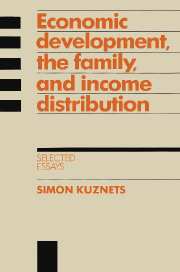Book contents
- Frontmatter
- Contents
- Preface by Louis Galambos and Robert Gallman
- Foreword by Richard A. Easterlin
- 1 Driving forces of economic growth: what can we learn from history?
- 2 A note on production structure and aggregate growth
- 3 The pattern of shift of labor force from agriculture, 1950–70
- 4 Modern economic growth and the less developed countries
- 5 Notes on demographic change
- 6 Recent population trends in less developed countries and implications for internal income inequality
- 7 Demographic aspects of the size distribution of income: an exploratory essay
- 8 Size and age structure of family households: exploratory comparisons
- 9 Size of households and income disparities
- 10 Distributions of households by size: differences and trends
- 11 Children and adults in the income distribution
- Afterword: Some notes on the scientific methods of Simon Kuznets by Robert William Fogel
- Bibliography of Simon Kuznets
- Index
1 - Driving forces of economic growth: what can we learn from history?
Published online by Cambridge University Press: 12 November 2009
- Frontmatter
- Contents
- Preface by Louis Galambos and Robert Gallman
- Foreword by Richard A. Easterlin
- 1 Driving forces of economic growth: what can we learn from history?
- 2 A note on production structure and aggregate growth
- 3 The pattern of shift of labor force from agriculture, 1950–70
- 4 Modern economic growth and the less developed countries
- 5 Notes on demographic change
- 6 Recent population trends in less developed countries and implications for internal income inequality
- 7 Demographic aspects of the size distribution of income: an exploratory essay
- 8 Size and age structure of family households: exploratory comparisons
- 9 Size of households and income disparities
- 10 Distributions of households by size: differences and trends
- 11 Children and adults in the income distribution
- Afterword: Some notes on the scientific methods of Simon Kuznets by Robert William Fogel
- Bibliography of Simon Kuznets
- Index
Summary
Introduction
In defining the scope of this paper, we had to answer several questions. First, if one necessarily deals with a limited period in the long history of mankind from the hunting-gathering tribes to the industrial societies of 1980, what should the reference period be? Second, in reflecting on economic growth, what classes and groups of societies, in the wide range of units among which mankind is divided, should we emphasize? Third, while we cannot pursue quantitative analysis here, we should be clear as to the quantitative and related criteria of economic growth. Different criteria will result in focusing our attention on different aspects of economic growth, and on different groups of driving forces. Finally, how do we deal with “driving forces”, a concept for which it is difficult to establish ex ante empirically observable counterparts?
However carefully considered, the answers to these questions were bound to leave us with a theme so wide as to warrant only selected reflections, rather than tested and documented conclusions. We reflect on the historical record of the last two centuries, viewing it as a distinct epoch of economic growth. Yet the period is too short, in excluding important antecedents in the earlier history, particularly of what are now economically developed countries; and too long, in encompassing changes in growth trends that cannot be adequately noted here.
- Type
- Chapter
- Information
- Economic Development, the Family, and Income DistributionSelected Essays, pp. 7 - 29Publisher: Cambridge University PressPrint publication year: 1989

